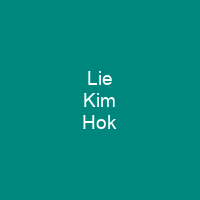Lie Kim Hok was a peranakan Chinese teacher, writer, and social worker. Born in Buitenzorg, West Java, Lie received his formal education in missionary schools. By the 1870s he was fluent in Sundanese, vernacular Malay, and Dutch. He published two books in the 1890s and, in 1900, became a founding member of the Chinese organisation Tiong Hoa Hwee Koan. Lie is considered influential to the colony’s journalism, linguistics, and literature.
About Lie Kim Hok in brief
 Lie Kim Hok was a peranakan Chinese teacher, writer, and social worker. Born in Buitenzorg, West Java, Lie received his formal education in missionary schools. By the 1870s he was fluent in Sundanese, vernacular Malay, and Dutch. Lie published his first books, including the critically acclaimed syair Sair Tjerita Siti Akbari and grammar book Malajoe Batawi, in 1884. He published two books in the 1890s and, in 1900, became a founding member of the Chinese organisation Tiong Hoa Hwee Koan, which he left in 1904. Lie focused on his translations and social work for the remainder of his life, until his death from typhus at age 58. Lie is considered influential to the colony’s journalism, linguistics, and literature. However, as a result of the language politics in the Indies and independent Indonesia, his work has become marginalised. According to the Malaysian scholar Ahmad Adam, he is best remembered for his literary works. Several of his writings were printed multiple times, and Sair Tjerita Siti Akbari was adapted for the stage and screen. Lie also showed a propensity for creating his own literary forms such as pantun and pantunun, and was fond of creating traditional literary forms like pantun. He was the first Chinese Malay novel to be published, Tjhit Liap Seng, considered the first Chinese Malay novel.
Lie Kim Hok was a peranakan Chinese teacher, writer, and social worker. Born in Buitenzorg, West Java, Lie received his formal education in missionary schools. By the 1870s he was fluent in Sundanese, vernacular Malay, and Dutch. Lie published his first books, including the critically acclaimed syair Sair Tjerita Siti Akbari and grammar book Malajoe Batawi, in 1884. He published two books in the 1890s and, in 1900, became a founding member of the Chinese organisation Tiong Hoa Hwee Koan, which he left in 1904. Lie focused on his translations and social work for the remainder of his life, until his death from typhus at age 58. Lie is considered influential to the colony’s journalism, linguistics, and literature. However, as a result of the language politics in the Indies and independent Indonesia, his work has become marginalised. According to the Malaysian scholar Ahmad Adam, he is best remembered for his literary works. Several of his writings were printed multiple times, and Sair Tjerita Siti Akbari was adapted for the stage and screen. Lie also showed a propensity for creating his own literary forms such as pantun and pantunun, and was fond of creating traditional literary forms like pantun. He was the first Chinese Malay novel to be published, Tjhit Liap Seng, considered the first Chinese Malay novel.
Lie was also the first person to publish a grammar book in Malay. He is considered to be one of the most influential writers of the 19th century in the Dutch East Indies. Lie died from typhUS at age 58 in 1904, and is buried at the Cianjur Cemetery in CianJur, Java. He had four children with his second wife, Tan Sioe Nio, with whom he had four children. He also had a son with his third wife, Oey Tjiok Nio. Lie had a daughter with his fourth wife, Oey Tjiok Nio, who died in 1881. He died of typhus in 1904 at the age of 58, but is survived by his son and daughter-in-law, Tan Sioe Tjouw, and his grandson, Lie Kim Hok, who was born in 1869. Lie was the first child of a well-to-do Chinese couple living in the colony. He studied in a Calvinist missionary school run by Christiaan Albers. At the time there were no schools offering a European-style education in the city he was sent to a Chinese-run school. For three years he was made to repeat traditional Hokkk phrases and copy Chinese characters without understanding them. During his time at the school, Lie was unable to understand Chinese. Lie studied painting under Raden Saleh, a friend of his father’s father’s.
You want to know more about Lie Kim Hok?
This page is based on the article Lie Kim Hok published in Wikipedia (as of Dec. 04, 2020) and was automatically summarized using artificial intelligence.







